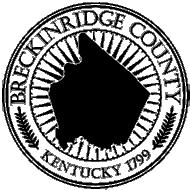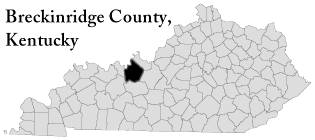 |
USGenWeb Archives Project Breckinridge County, Kentucky |
 |
 |
 |
 |
 |
USGenWeb Archives Project Breckinridge County, Kentucky |
 |
 |
 |
 |
THESE
ARCHIVES BUILT BY YOUR
CONTRIBUTIONS.
PLEASE CONTRIBUTE TODAY!
New
Easy to use Submission
Forms!
This Page Updated Monday, 11-Apr-2022 20:27:41 EDT
| BRECKINRIDGE COUNTY, KENTUCKY |
| AREA COMMUNTIES OF THE PAST AND PRESENT |
| AXTEL |
The people of Breckinridge County have always been very
patriotic. Through the War of 1812, the Civil War, the two great
world conflicts
and the hot beds of confusion since the Korean crisis,
Breckinridge County has always contributed her share of good
fightingmen.
In the south end of the county near Axtel, there is a very
peculiar rock formation, called Sand Knob.
This knob is not
more than twenty
or thirty feet in width at the top and the walls are practically
perpendicular. At
the front of the knob it rises to over
110 feet high. The
back end
slopes off to meet the ridge overlooking Rough River Lake. It
is a very picturesque place and thousands of people visit it for
picnics as it can be seen
from ten to twenty miles away on a clear day.
It was on
this knob that a celebration worthy of mention and characterizing
the patriotism of the Breckinridge
County people was held. At
the end of World War U, as soon
as word had penetrated that portion of the county that the
Armistice was signed, word
was circulated that there would be a flag raising on top of Sand
Knob. People came
from every corner of the county and Mr.
Sidney Owen rode his
horse up on top of the knob carrying with him the American Flag,
in what he called a befitting fashion.
The main speaker of
the occasion was Father
Odendall. Today the
knob is owned by Hughes Goodman who is
planning to, at some future date, develop it into some kind of a
tourist attraction.
Axtel itself came into being in a rather unique way. One of
our first industries was located near Axtel on what is now known
as the
Bowles place. It
now belongs to Hughes Goodman. It
was a tan yard, owned and operated by a Mr. Billy Cannon, the
same one that was impaneled
on the first grand jury that met in Hardinsburg in April 21,
1800. People for
miles around brought their hides there,
whether cow, horse, or mule, to have
them tanned. There
was a certain kind of oak bark that he
used to tan the leather.
Many of the families in the early days of the frontier
were
obliged to make their own shoes or go barefoot, which thing they
did in the warmer months,
except on special occasions. With
the tan yard and plenty
of good leather it was only natural that another citizen of that
community should take up the trade
of cobbling.
Elias Rhodes, who was the first of the clan to come to the
county
in the early eighteen hundreds, was the shoe cobbler.
He is
reputed to have
been one of the finest shoemakers in this part of the state.
Elias Rhodes was the father of Frank, the father of Billy,
the
father of Francis, living now at McDaniels.
Soon after the country around Axtel was settled and
several
families had moved into the community, some of the earliest being
that of Cannons,
Bennets, McCrackins, Jarboes, Owens, and McClellands, there arose
the need for a post office. As
yet there was no name for
the community, and one must
be had before they would be allowed to have a post office. Mr.
Bennett, who was one of the leading citizens, wrote to the
Postmaster General and asked him
to give them a name for their post office which they had applied
for. His letter
read like this: “Dear Sir.
We
have wrote to ax yo to tel us a name fo our
post office.” The
postmaster answered his request and
named it Axtel. These
things sound funny to us today, but
these were great men who worked
hard and got the job done and left us a great heritage.
The Methodist Church was built in 1913, and was torn down
in
1958. It was the
only Protestant church in the community.
The author’s wife was born the day the church
was dedicated
and twenty-five years later was the first person to be married in
it. It continued to
act as a beacon
light in the community until the Rough River Dam was built and it
was below the government easement line; therefore, it had to be
moved to a new and higher location.
I wonder why that church was ever built.
Was it because men feared the wrath of God?
Was it because their hearts were full of guilt?
For trampling his love beneath the sod.
Our sins are never healed by the rod.
Nor was that why that structure there was raised.
Each Sabbath morning found them as they trod
To offer adoration there and praise.
That’s why the church was built and why always.
It pays to plant your feet on “higher
ground”.
That Church is gone, God pity us these days,
For in that little Church is where I found
The grandest thing that ever comes in life,
A vow was made and She became my wife.
The new church was built in 1958, on Highway 108 two miles
north
of the Rough River Dam. Probably
the oldest member of the
congregation is Mr. C. T. Jarboe, who helped to build the old
church and lived to see it torn down and was very instrumental in
getting the new one built
where it stands today.